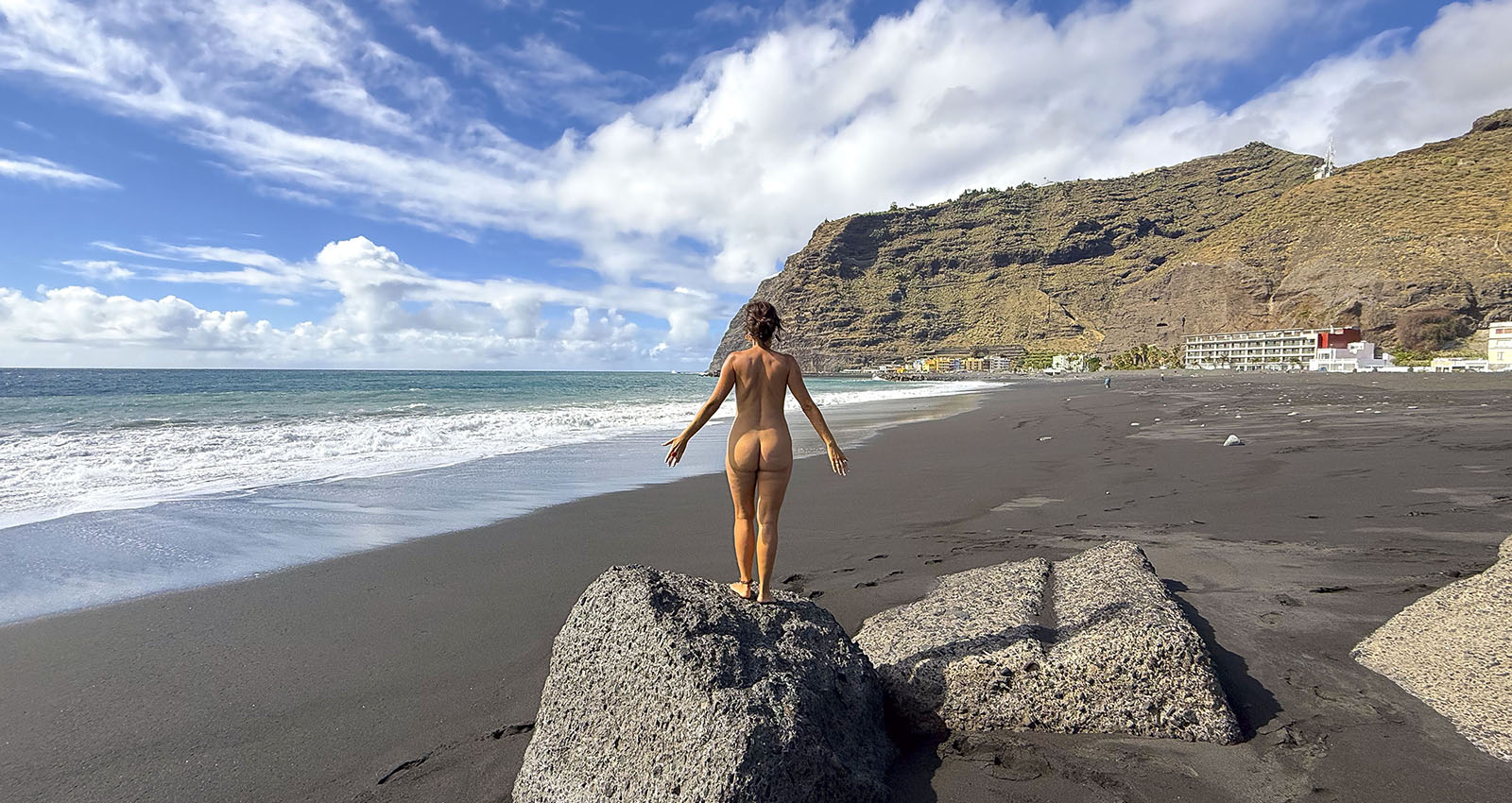The small ferries that stitch the western Canary Islands together feel like time machines. We left the crowded promenades of Tenerife behind, and less than an hour later, arrived at steep amphitheatres of volcanic rock, terraces shaped by hand, and a rhythm that invited us to slow down.
On La Gomera and La Palma, the shoreline is not a set of beach clubs and boardwalks. These are wild places, where cliffs pour into the sea and long stretches of black sand hold the last light of the day. We came to find nude beaches, but found much more than that. This is back to basics at its best.
Before we dive into the beaches, a quick note. Only one of the beaches below is an official nude beach, but since the Canary Islands are a part of Spain, nudity is legal on any beach. Thanks to the relaxed atmosphere of La Palma and La Gomera, it’s also generally accepted to be naked as long as you walk a bit away from the crowds. In our experience, the fact that there’s only one official nude beach doesn’t mean that they don’t want more, they simply don’t need it.
La Gomera: barefoot calm with a streak of adventure
Playa del Inglés, Valle Gran Rey
At the northern edge of Valle Gran Rey, Playa del Inglés sets the tone for La Gomera. This formerly hippy town may have lost a bit of its charm from dipping its toes into commercial tourism, but the general vibe is still unhurried and a little bohemian. Its coastline is a broad stretch of black sand broken by rock shelves and small windbreakers built from rounded stones.
Reaching Playa del Inglés (not to be confused with its namesake on Gran Canaria) is straightforward. A short footpath drops from a small parking area to the sand, and within less than a minute, you are below the cliffs with the Atlantic filling your view.
The ocean here often shows its muscle. Breakers can be powerful, and the slope of the beach adds to the pull, so choose your entries carefully. On calmer afternoons, it becomes a perfect place to stretch on the warm sand and let the wind be the only soundtrack.
Bay of Pigs, Valle Gran Rey
From the south of town, Bay of Pigs (not to be confused with its namesake in Cap d’Agde) beach looks like a secret cove. It can be admired from a distance when you’re standing in the town’s port, and when we were here in February 2025, this was the best we could get. Rockfall had closed the access path, and many signs indicated the danger of taking the hike.
When the trail reopens, it will once again make a dramatic addition to your clothes‑free day in Valle Gran Rey, but even at a distance, the view is worth the pause. It is a reminder that these islands are living geology and that closures are there for a reason. On the more popular islands, governments would be adding metal nets and concrete, but here they just let nature do its thing. Even if it’s not always convenient for the island’s visitors.
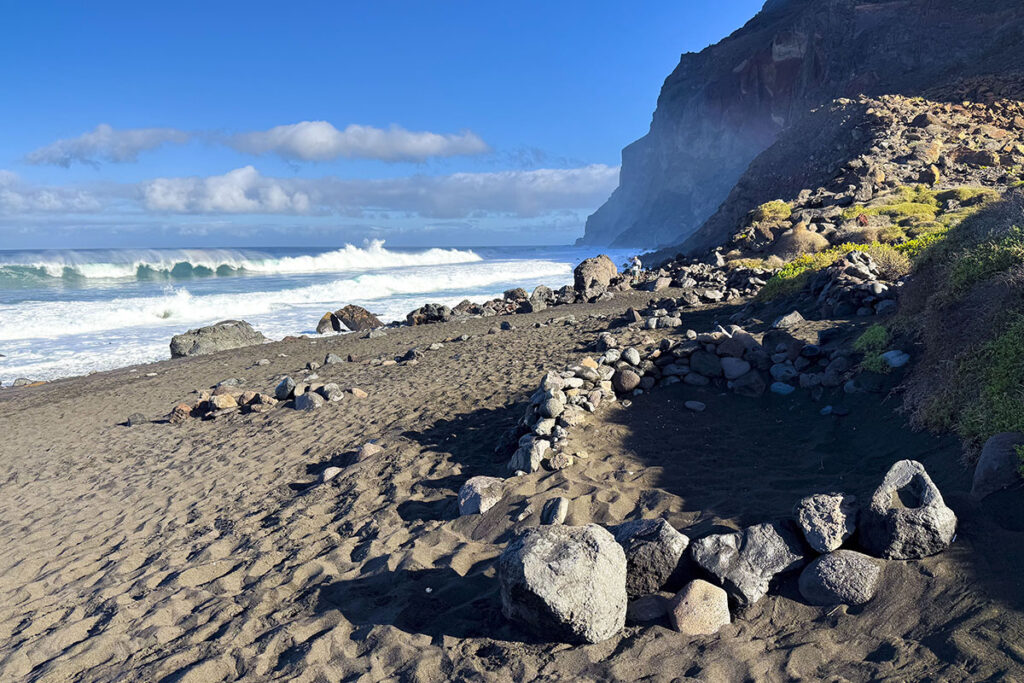
El Cabrito
The cove at El Cabrito is a rarity in the Canaries because the settlement behind the beach has no road access. There is one small hotel at the beach, and if you’re staying there, you will be picked up by a small shuttle boat from San Sebastián. Everyone else earns their skinny dip on a spectacular mountain path of about ten kilometres.
We took the trail and loved how the journey kept unfolding. High terraces, goat paths, and sudden frames of open sea all lead to a beach where a cold drink feels like a medal. Along the way, several small coves appear below the cliffs, places where clothing is uncommon and solitude comes easy.
Guidebooks call this an “intermediate hike”, especially due to its length and several ups and downs. Always keep in mind that you also have to hike the whole way back, so if you start feeling tired, it’s always an option to skip El Cabrito and just skinny dip on one of the beaches along the way.
Playa del Medio and the quiet coves east of Playa Santiago
Valle Gran Rey may have lost some of its hippy vibe, but at Playa del Medio, it’s flourishing like never before. The coastline is dotted with caves where people who want to disconnect from the outside world come to live for a few months, a whole year, and sometimes even a lifetime.
Playa del Medio itself is a pebble beach with a simple charm. It is classic La Gomera, an oasis of calm set against a backdrop of raw rock. Entry to the water is step by step, watching the waves and timing your move. From here, you can continue on foot to two more beaches. Both see their share of nude swimmers and make you feel as if you’re the only person in the world.
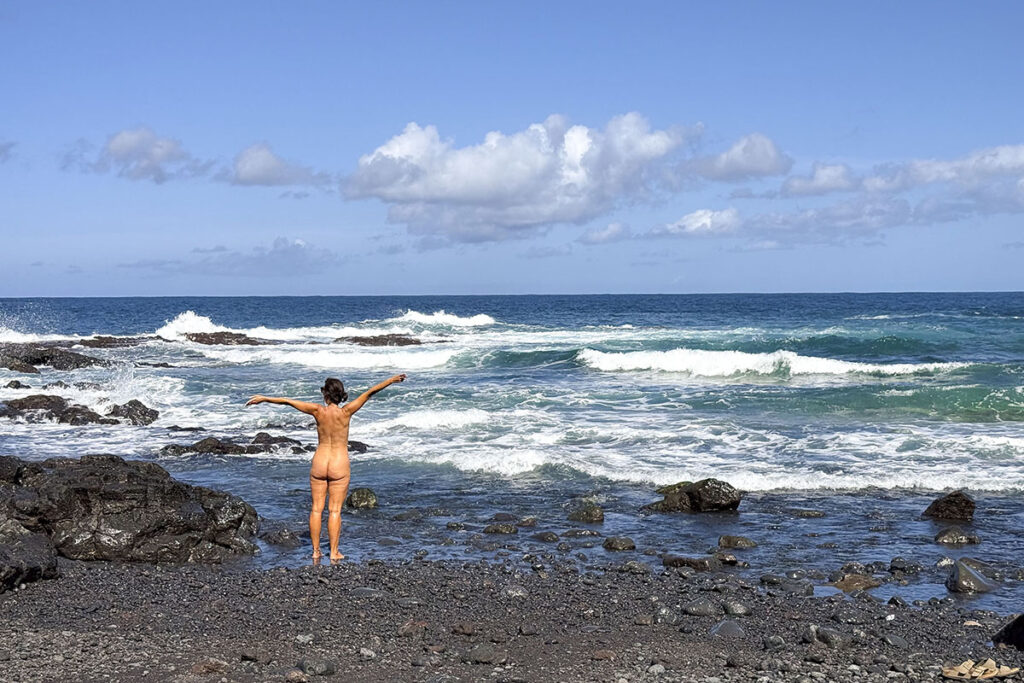
La Palma: dramatic coasts and easy access
Tazacorte
On La Palma, the best starting point is Tazacorte, the only official nude beach in this overview. There’s a clearly marked nude section that sits at the edge of the town’s broad black‑sand beach. Parking is in the town itself. Facing the sea, walk left along the shore to reach the clothes‑free stretch, which is right next to the dog beach.
Access could not be simpler, and the proximity of cafés and showers makes it an easy first stop if you have just arrived on the island. The sea here can still be pushy, so it’s often better to limit yourself to a refreshing dip and a long dry‑off in the sun.
Playa de Echentive
All the way to the south of La Palma, Playa de Echentive is a long black sand and pebbles stretch that creates contrast with the volcanic ruins and a photogenic lagoon. This is a place where day‑trippers come for the scenery and linger for the swim.
If you work your way toward the edges of the beach, it is possible though to settle into a more clothes‑free rhythm. The mix of textures underfoot makes sandals useful from towel to waterline. On days when the wind blows from the south, the air smells of salt and basalt and the whole scene feels like a science fiction movie.
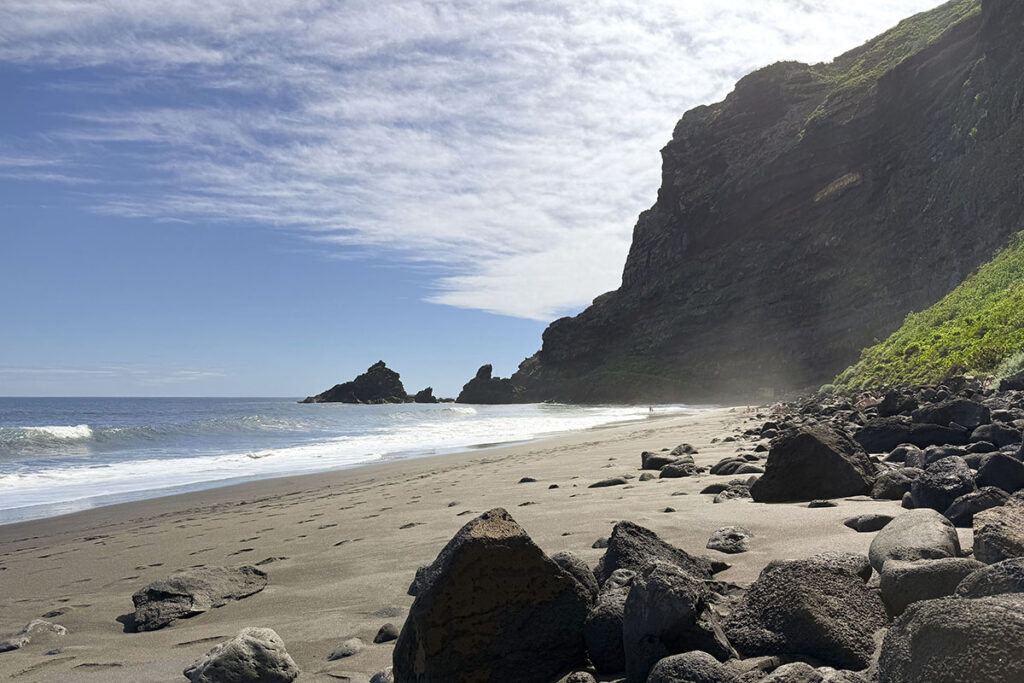
North to Charco Azul
Charco Azul is one of La Palma’s famous natural sea pools. It is spectacularly beautiful, but also overcrowded with bathing suits. Here, nudity is a big no-no. But a short path leads to a neighbouring cove where the mood changes. Large rounded rocks create pockets of privacy, and patches of sand offer a place to spread a towel.
These coves may not be as picture‑perfect as the pools, yet for us, this little corner holds the better memory. Getting out of the water with goosebumps and warming on the dark sand is half the pleasure.
Playa de Nogales
We saved Nogales for a day with time to spare. Parking sits high above the coast, and a well‑kept trail winds down the cliffside in broad zigzags. The walk itself is a highlight, every turn revealing a wider sweep of Atlantic and cliff. At the bottom, the beach opens like a stage. It is long, volcanic, popular with surfers, and framed by walls of lava that rise seemingly all the way into the clouds.
While the whole beach is tolerant of nudity, the atmosphere becomes more clothes‑free as you wander away from the main entrance. On a sunny morning, the black sand stores heat and the breeze smooths the edges. Timing is crucial here because shade falls over the beach quite early in the afternoon. So plan accordingly.
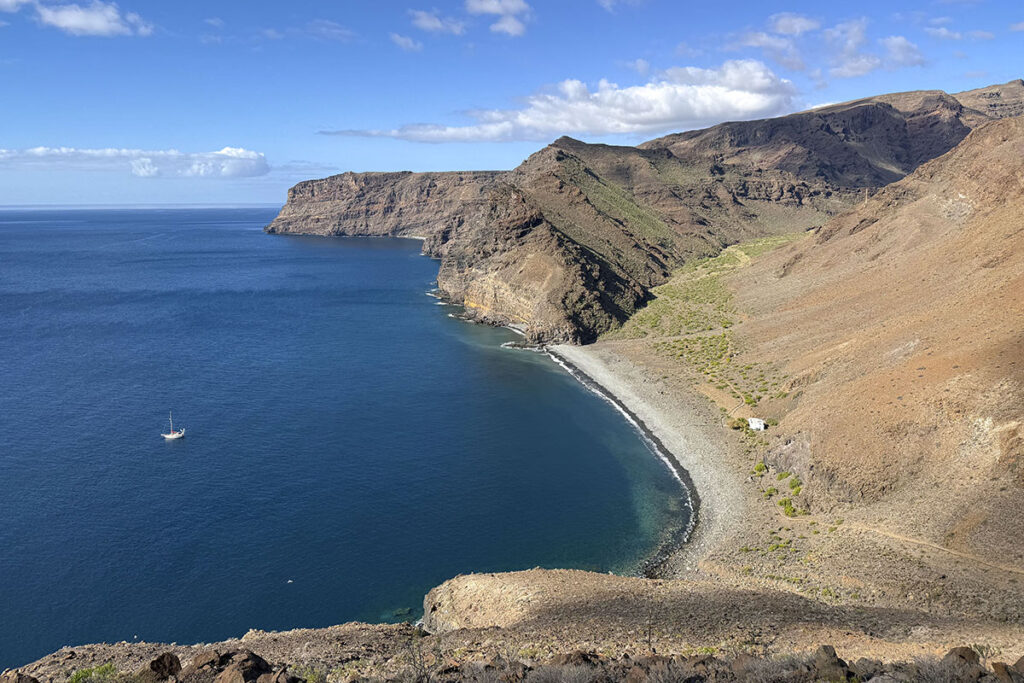
Why you should visit La Palma and La Gomera
We asked a group of local kids on La Gomera what they do to party at the weekends. They replied: “Take the ferry to Tenerife”. This kind of summarises what these islands are all about. They are not commercial holiday destinations that are built to keep people entertained. Instead, they have an abundance of wild nature that can entertain you much longer than any club or hotel ever can, if you’re up for this.
But maybe most importantly, these islands don’t come with a dress code. At two beaches, we found signs prohibiting nudity. They were just plainly being ignored. If you like rough nature, solitude, and swimming without swimsuits, these islands will definitely be your thing.
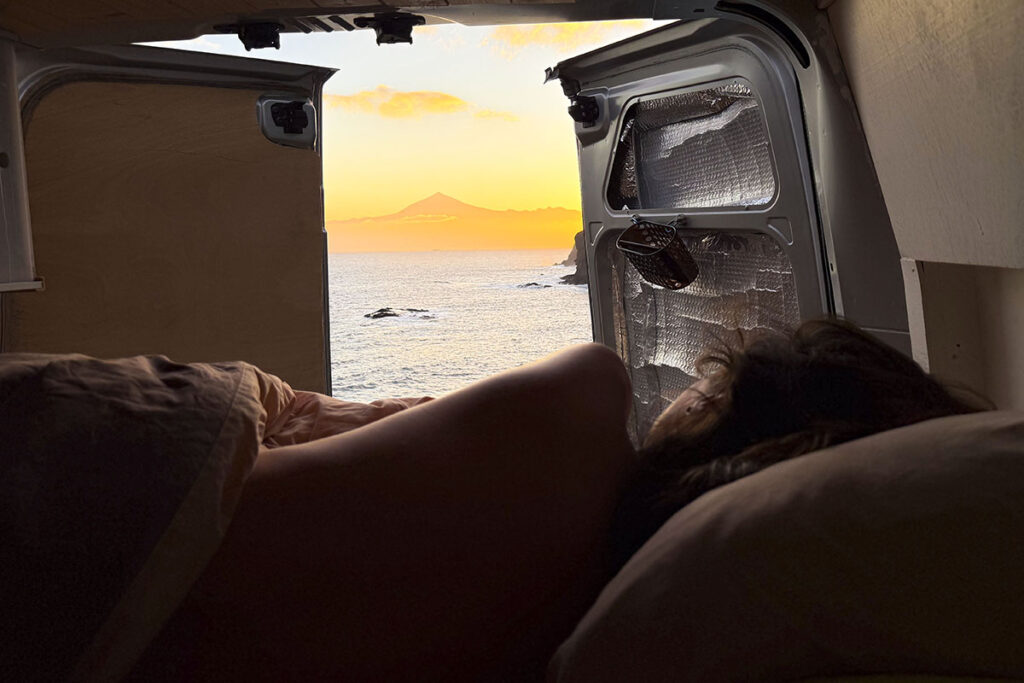
Where to stay
There are no naturist resorts on La Gomera or La Palma. Campgrounds are few and close down for the winter season. Yet, we found that (campervan) camping was by far the best way to explore the islands because wild camping is generally accepted, as long as you don’t make a mess. It’s often possible to camp in parking lots right next to the beaches.
For a roof and a hot shower, there are small hotels in the seaside towns and a wide choice of rural houses and holiday rentals scattered through the valleys. But be careful because the roads are often not for the faint-hearted. Choosing a place within an easy drive to the nude beaches makes early swims and sunset returns much smoother.
When to go
We visited both islands in February and March, which is often considered the high season on the Canary Islands, with temperatures in the early 20 °C, lots of sunshine, and not too much wind. Perfect to spend some time naked on the beach, but also still agreeable for long hikes in nature.
Weather-wise, there isn’t really a bad time to go to the Canary Islands, but keep in mind that July and August are the busiest months. The huge crowds never make it to La Gomera or La Palma, but the vibe may be a bit busier and more clothed.
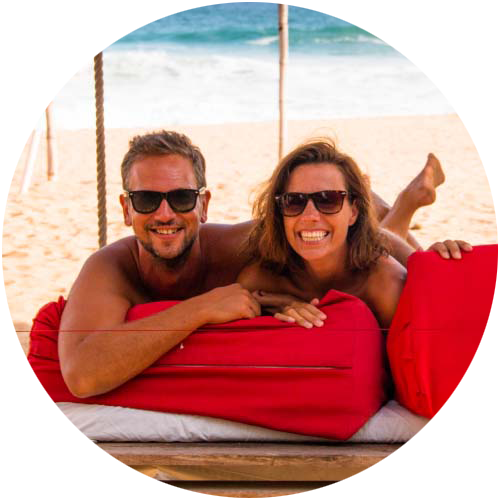
Support Naked Wanderings
Do you like what we do for naturism and naturists?
Did we make you laugh or cry?
Did we help you find the information you were looking for?
Then definitely join our Patreon community!


